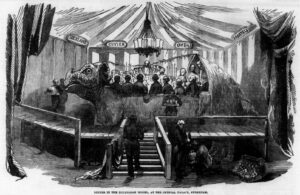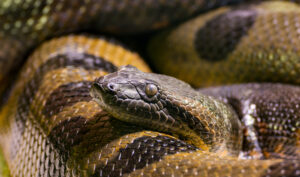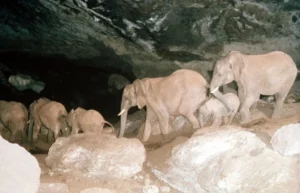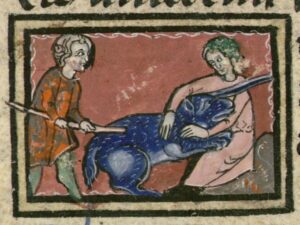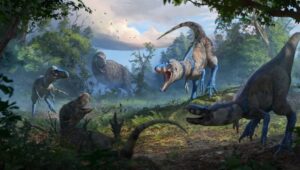When Kyle Atkins-Weltman bought some fossils online for one of his research projects, he thought he knew what he was buying. Atkins-Weltman ordered Anzu wyliei fossils, a dinosaur nicknamed the “chicken from hell.” But the bones were far more interesting. He’d been sent bones from an undescribed species. Atkins-Weltman named the species Eoneophron infernalis, which translates to “Pharaoh’s dawn chicken from hell.”
A lucky mistake
The PhD student was trying to finish a project but was unable to find the bones he needed. Unable to continue without the bones, Atkins-Weltman spent $5,000 for four Anzu wyliei hind limb fossils: a femur, a tibia, and two metatarsals.
At first, he thought the bones were from a juvenile. But after scanning them, he realized they were from an adult of a smaller unknown species.
“I felt my heart skip a beat. I was like, is this really happening to me this early in my career?” Atkins-Weltman told Live Science.

Right tibia and astragalocalcaneum of Eoneophron infernalis. Image: Atkins-Weltman KL et al., 2024
When you cut open bones you can see rings, known as lines for arrested growth. They are similar to the rings of a tree. Atkins-Weltman and a research team assumed that the smaller bones belonged to a young A. wyliei. Young specimens are incredibly rare and they wanted to study the bones to find out more about how the dinosaurs developed. Instead of the expected widely spaced lines, the cross sections showed lines that got closer together. This dinosaur was almost adult-sized, it couldn’t possibly be a “chicken from hell.”
With a new species on his hands, Atkins-Weltman put considerable thought into naming the dinosaur. Eoneophron is a combination of the Greek word ‘eos’ (dawn) and Neophron, the genus that includes Egyptian vultures, which are often called ‘Pharaoh’s chicken.’
The second part of the name, infernalis, is from the Latin for hell. The name links the species to the original “chicken from hell” species and is a nod to Atkins-Weltman’s old pet, a Nile monitor lizard called Pharaoh.
A smaller, lighter hell’s chicken
Eoneophron infernalis is from the late Cretaceous and the research team believes is it from the South Dakota region of the Hell Creek Formation. Though it is a separate species from A. wyliei, the two are related. Both are long-limbed, toothless, beaked oviraptorosaurs from the Caenagnathidae family. There is considerable evidence suggesting that the birdlike dinosaurs sported feathers.
The main difference between the two species is their size and leg structure. The original “chicken from hell” weighed between 200-340kg. E. infernalis is smaller at around 78kg. The new species seems better evolved to cope with stress while running. In the larger dinosaurs, only the astragalus and calcaneus ankle bones were fused, but in E. infernalis the tibia is also fused.

Images showing the fusion of sections of the hind limbs. Image: Atkins-Weltman KL et al., 2024
A versatile species
The discovery sheds more light on the diversity of dinosaur species. In the few million years before the asteroid strike, some scientists have argued that many dinosaurs were in decline. This seems to include the tyrannosaur and lambeosaurine groups. In contrast, the caenagnathids seemed to be flourishing.
“This group seemed to have maintained stability and diversity whereas other groups suffered. My guess is they were omnivores and very versatile, switching food sources to survive,” Atkins-Weltman said.
Atkins-Weltman has now donated the fossils to the Carnegie Museum of Natural History. Though he bought them, and realizes it sounds hypocritical, he does not agree with the commercialization of fossils. Holding them in private collections makes the bones useless to science and any information they hold is effectively lost.

